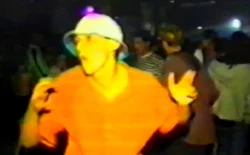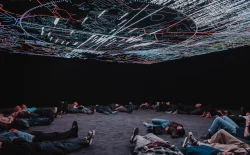“If you look at all the greatest artistic and technical achievements in the world, they’re usually driven by one mind,” says Sinjin Hawke. “With Zora [Jones] and I, we have a dual-mind – we’re almost the same person.”
That “dual-mind” was in full effect when I spoke with Hawke and Jones via Skype from their Barcelona home, especially since they often finish each other’s sentences. But even though the co-founders of Fractal Fantasy – the creative platform that houses their audio-visual work – are romantic partners in addition to creative ones, it’s not a rom-com cliché. It’s more like a never-ending relay race of information – a race that has taken them from mashing-up their club constructions with film snippets to launching an interactive audio-visual platform to (in Hawke’s case) collaborating on Kanye West’s The Life of Pablo. When I mention a clutch of Hawke’s bootlegs that surfaced in 2011, the pair laugh at how long ago that was. “A lot has happened since then,” says Hawke, who doesn’t feel like five years have passed. “But when I look back at how much stuff has been done, it makes sense.”
Hawke and Jones met during the summer of 2010, when Hawke played Barcelona’s Razzmatazz. Jones was a fan of his music and the two hit it off; Hawke says there were “definitely some sparks” right away. Jones visited him in Montreal, and he moved to Barcelona in 2011, which presented him an environment – no friends, plenty of time – that allowed him to hone his craft and assemble his debut EP, The Lights. At the time, Jones was in fashion school, a time-intensive pursuit that only allowed her enough time to dabble in production. Seemingly with Malcolm Gladwell’s 10,000 hour rule in mind, Hawke advised her to make 100 songs before releasing anything, a project that would eventually be whittled down into 2015’s 100 Ladies EP. “It was the best advice I ever got from anybody,” she says. “I was really able to find my own sound.”

Zora Jones
In the intervening years, most of Hawke and Jones’ artistic output has been through Fractal Fantasy, a platform (not a label, they stress) that they launched in 2012. They had collaborated on ‘VClipse’, a song that Hawke thought sounded like “a slow-motion drive-by,” and they paired it with the iconic intro from Belly. “It felt really cohesive,” Jones explains, “so I thought it would be great for it to have a space to live in and exist in,” rather than popping up on Vimeo and social media timelines before being lost in a crush of content.
After toying with a bunch of “lame names” for the project, the pair decided on Fractal Fantasy, borrowing the name from a video that Hawke’s father, musician and pioneering 3D software programmer Duncan Brinsmead, made back in 1987. “It might look like typical ‘80s graphics, but at the time it was quite groundbreaking,” says Hawke. “A lot of the techniques hadn’t been done at the time, and he had to code the entire framework that he was working in.” The way that the music informed the visuals and the visuals informed music provided a philosophical approach for their new platform. “Unifying visuals with sound bilaterally seemed like a great idea to us,” said Jones.
“We learn as we go, anything that we get interested in we try to learn it ourselves.” Zora Jones
Brinsmead’s demoscene-styled journey through 3D space (soundtracked by music he created with some primitive software on the Amiga) also provided a visual inspiration for Fractal Fantasy’s next few videos. And as a key developer of Maya – Hawke describes it as “the program that pretty much every movie company uses to make 3D effects in movies” – the elder Brinsmead offered not just his expertise but old demos that soon became reference points for their videos.
Take Hawke’s collaboration with P. Morris, ‘Ferrofluid’, as an example: named after a liquid that becomes magnetized in the presence of a magnetic field, they had wanted to film a vat of ferrofluid as it responded to impulses in the music. “That would have been extremely expensive and we ended up not doing that,” Jones laughs. Instead, they digitally recreated the scene within Maya – using liquid solvers that Brinsmead had programmed – and used the music’s bass signal to stimulate the digital fluid, an approach they used on same approach on Hawke’s collaborations ‘Flash Alert’ (with L-Vis 1990) and ‘Thunderscan’ (with MikeQ).

Sinjin Hawke
Beyond the computer-based similarities between producing electronic music and programming 3D visuals, though, Hawke and Jones find the processes to be very different. They are both self-taught in their CGI exploits, and a DIY spirit drives their work. “We learn as we go, anything that we get interested in we try to learn it ourselves,” Jones says. “It gives us the most control over the process.” That sense of control underlies all aspects of Fractal Fantasy, from writing, recording, mastering and mixing music to coding, designing and animating the visuals and their website. “It’s a way more honest expression if everything you do is done by yourself. It makes the whole thing a lot more personal to people,” Jones explains, to which Hawke adds, “honestly, we’re experimenting with software, and we hit limitations. At the end of the day, we’re not very experienced with animation or code, so we do whatever we can and then it’s syphoned through filters in our brain.”
Along with those “filters”, Fractal Fantasy is driven by one key visual influence: the cinematography of director Hype Williams – “huge wide angles, in-your-face shots, the color palettes,” says Hawke – has been a “huge fascination” of both Hawke and Jones since childhood. They point to Busta Rhymes and Janet Jackson’s ‘What’s It Gonna Be?!’ video as a specific touchstone, but note that – rather than costing millions of dollars – they can achieve similar visual effects for “practically nothing”.
“We want to be able to do everything.” Sinjin Hawke
Until last year, Fractal Fantasy’s output was comprised of six videos; Hawke and Jones would go on to release the audio as a compilation entitled Visceral Minds, a move that seemed to be a concession to fans and DJs that craved a more traditional release. Since then, Fractal Fantasy has doubled down on non-traditional projects: Hawke and Jones have provided sound design and music for interactive experiments like Ezra Miller’s abstract “Unction” and Altered Qualia’s “Uncanny Valley”, the latter of which explored the titular phenomenon with a handful of computer-generated faces. Even when Hawke and Jones have released music, they’ve coupled their work – whether a mix, a bootleg compilation, an EP or a single – with interactive visuals and 3D spaces (often by Miller) that can be explored in 360 degrees.
A 19-year-old code artist, Miller met Hawke and Jones when they played a gig in Chicago. “At that point, I was banging my head against the wall with code and I needed a friend to help me out,” Hawke explains, and they quickly started bouncing ideas off each other. “I was a huge fan of Sinjin and Zora’s before I was able to work with them, and getting to know them over the last year has been so fun – they’re some of my closest homies now,” says Miller, who balances schoolwork and a freelance client list that includes Travis Scott and Adult Swim. “Their creations are some of the most innovative, forward-thinking, futuristic audio-visual experiences out there and I feel blessed to be able to be a part of the creative team.”

“I’m all about utopian futures.” Sinjin Hawke
In the same way that Fractal Fantasy was not founded with a mission in mind, there is no set goal with its output. “I’m not sure that we’re really trying to do anything, it’s more that we get obsessed with things,” Jones says, adding with a laugh, “in a really nerdish way.” The pair follow these “fascinations” until they’re bored with them, and have opted not to formally define Fractal Fantasy. “We don’t want a definition to narrow down what we’re allowed to do,” Hawke explains. “We want to be able to do everything.”
Recently, they’ve been fascinated with the possibilites of WebGL and Javascript libraries that turn web browsers into game engines and allow for interactive, real-time 3D pieces. Rather than the laborious, time-consuming process that 3D rendering usually requires, WebGL offers immediacy that is “extremely gratifying”. “Remember back in the ’90s, when you’d go to a website and find a picture, and it would load line by line? That’s what it’s like working in 3D, and with WebGL it’s much more satisfying,” Hawke says.
Hawke and Jones maintain that – outside of a few visual influences – it is the technology that is driving Fractal Fantasy’s visual work. “What we’re doing is based in what’s actually happening,” he says. “There are all these new technologies that are coming out now that we’re fascinated by: VR is becoming a reality, AR [augmented reality] is becoming quite interesting.” As Jones says, “if you look at how we live in 2016, we live URL and IRL… It’s the natural progression for us to work in that angle.” Despite the “fantasy” of their name, Fractal Fantasy is all about reality: these technologies have gone from science fiction to scientific fact in the course of the duo’s lifetimes. “I’m all about utopian futures,” Hawke says. “We have all these new technologies emerging that might solve a lot of our problems, and to look at it and say “we’re doomed” is a bit difficult for me. A lot of things that happen with these technologies is positive.”
Along with balancing URL and IRL, Hawke and Jones must balance being artistic partners and romantic ones. “For me, it’s the best thing ever. The most fruitful way of working is with someone who is completely on the same page in terms of motivation, goals, wanting to do stuff properly,” says Jones. Hawke agrees, noting the importance of a “sparring partner” with whom to collaborate. “It’s good to have someone to bounce a ball off of. If you don’t, you can feel lost.” And while they are each other’s main collaborator, they’ve also worked with producers that they consider family, “not just random people we met once in the nightlife,” Jones says. On Visceral Minds, they worked with L-Vis 1990, MikeQ, P. Morris and DJ Taye. Hawke has since worked with Gangsta Boo and Sicko Mobb, and the pair are already working on Visceral Minds 2, which is set to feature club music heavyweights DJ Sliink, Beatking, Canblaster, L-Vis 1990, Jlin and others.
Hawke’s latest collaboration is his most high profile one: he co-wrote and co-produced Kanye West’s ‘Wolves’ (and companion piece ‘Frank’s Track’). As he tells it, Hawke had been working on a “really dark, menacing Timbaland kind of rhythm” with Cashmere Cat when the pair decided to make a “nice song” as well. Hawke added some synth choirs to one of Cashmere Cat’s chord progressions, and stripped it down until it was a “sad, minimal beat”. The track eventually caught the ear of West, who turned it into ‘Wolves’ and premiered it at his Yeezy Season 1 show last February. “It was super surreal,” Hawke recalls. “It was quite emotional to hear someone that you’ve grown up listening to use your stuff.”
In the run-up to the release of the album that would become The Life of Pablo, Hawke reached out to West’s righthand-man Virgil Abloh, who told him the album wasn’t done and requested more beats. Hawke and Jones immediately got to work, turning several years worth of “sketches and doodles” into fleshed-out instrumentals and songs. The pair worked day and night and slept on a timer to “maximize [their] output”, finishing about 50 songs that they sent to West’s people in batches. Due to a non-disclosure agreement, Hawke can’t detail what happened when he actually hit the studio, but when he returned home, he had a collection of finished songs. He had essentially written his whole album.
The album is forthcoming on Fractal Fantasy, and while Jones has also been working on her latest batch of demos, she’s mostly been focused on Hawke’s record. “It’s definitely the best music he’s ever done,” she says. “It sounds really big but it’s such an intricate personal record, it’s incredible.” She jokes that she shouldn’t be the one talking about it, but as one half of a dual-mind, who would be better?



















![180 Studios presents new Ryoji Ikeda installation, data-cosm [n°1]](https://factmag-images.s3.amazonaws.com/wp-content/uploads/2025/10/ryoji-ikeda-data-cosm-1-250x155.webp)










